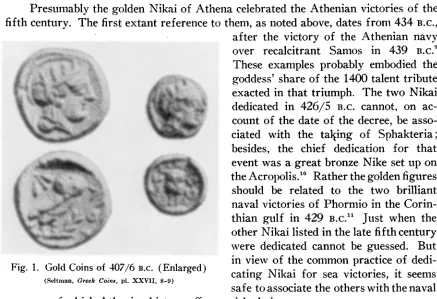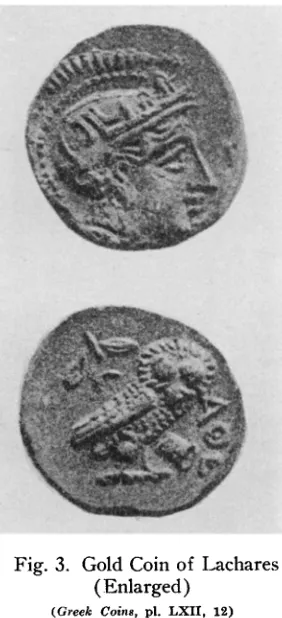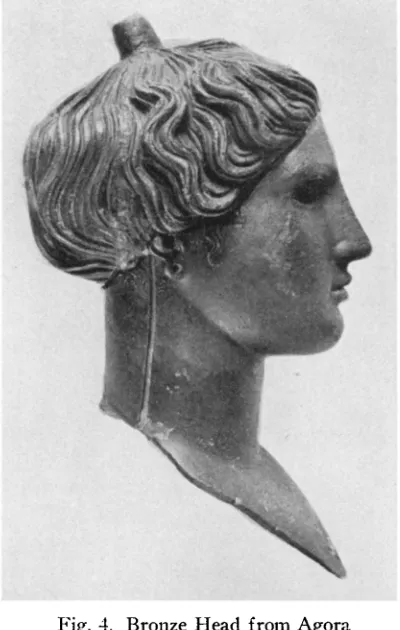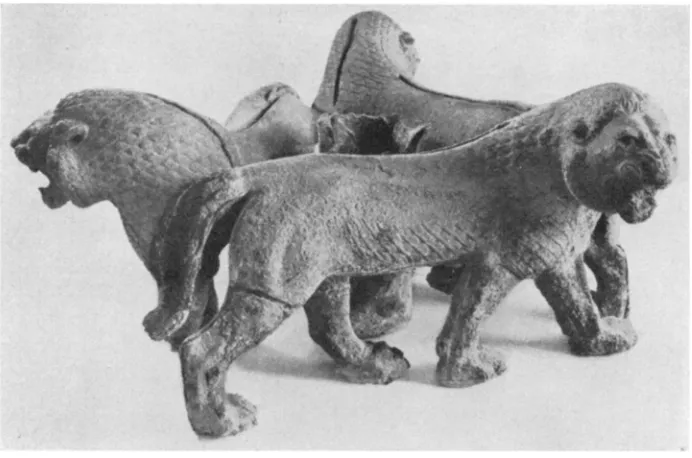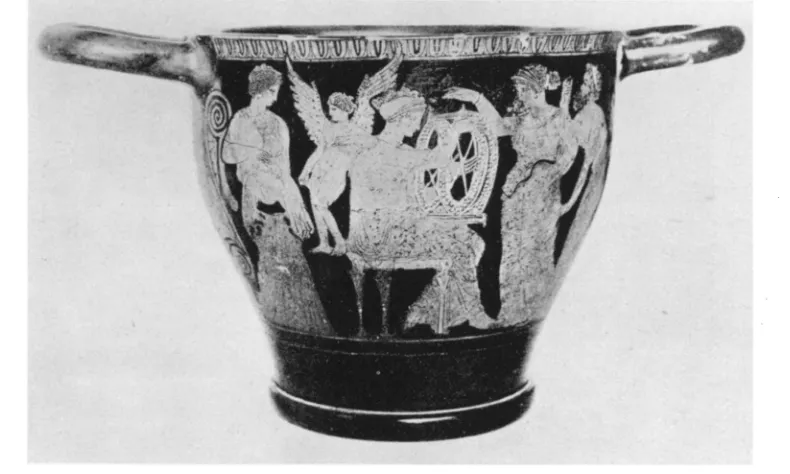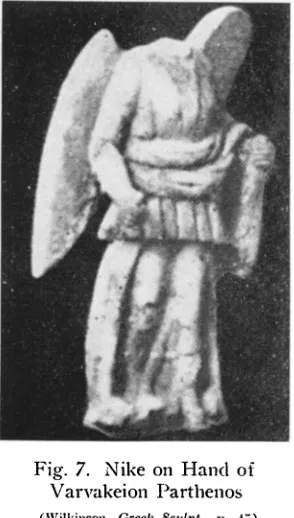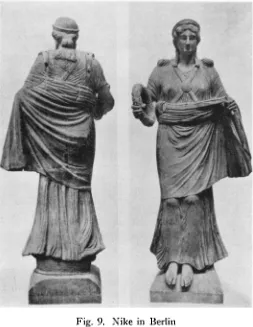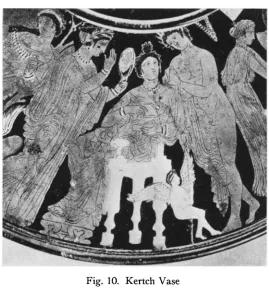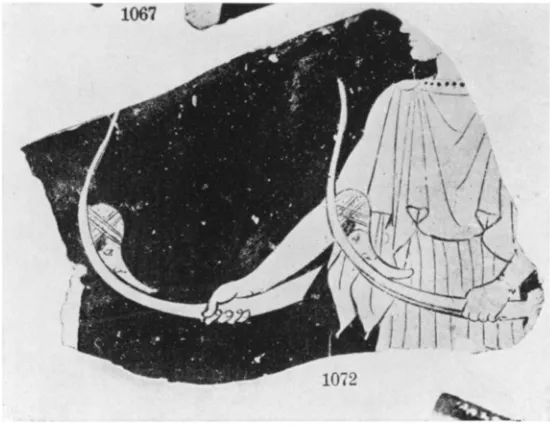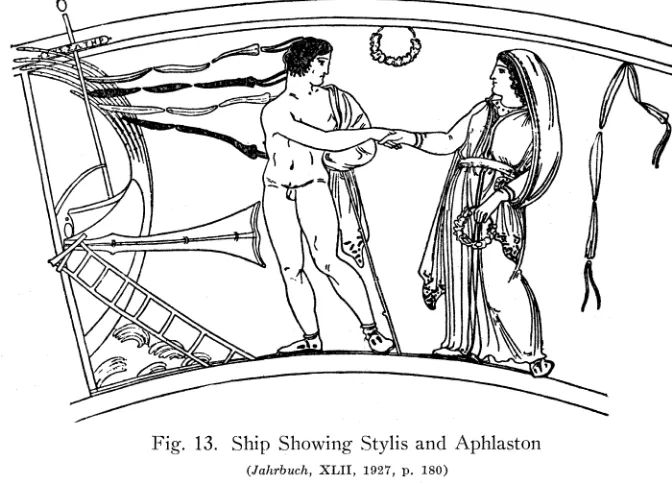In the Parthenon as reconstituted by scholars, our eyes have been so dazzled by the colossal gold an(d ivory statue that we have scarcely noticed her handmaidens, the golden victories of -Athena. Our attention has been drawn to them again by the thorough study of all the relevant inscriptions bv Mr. Woodward.! These inscriptions together with a f ew scattered literary references considered in connection with a bronze head recentl T discovered in. the Agora 2 provide sufficient -material to tempt one
to reconstruct the Nikai.
The Parthenos and these Nikai alike wvere the expression of the prudence of Perikles, who believed in fortifying the state by great reserve funds rather than by
mortgages on
-futureearnings:
at E 1rEptovrtat,he sagaciously observed,
ro009 1owX4ov9 paAXXov i) at l3tatot Eo-kopat avE'Xovor-tv (Thucydides, I, 141, 5). These financial reserves were translated into a spiritual investment bv dedicating them to the Goddess. TlLus the Athenians could lay ulp) their treastures in heaven while still keeping their hands oni thenm. 'But when theyr w.ere obliged to convert these golden statues into money,they
wvere carefullnot to say
KaTaKo4p0LeV Ta'&g NtKas E s r6v TO r6,vbout
v/ XP70oPrats N'Kat9 Elq r\v IoTXEf0ov.' Piety an.d prudence could botlh be satisfied by turning useless bullion into works of art. Furthermore, there was undoubtedly serious pres- sure to keep in employment the skilled craftsmen wvho had been released from occupa- tion when the Parthenos was dedicated in 438 B.C. Perikles, be it remIembered, kept hlis eye on labor conditions. "'it being- his desire and design that the undisciplined mechanic nmultitude that stayed at honle should not go without th-eir slihre of the public salaries and yet shotuld not have th-iem given them for sitting still and doing nothing,
'"The Golden Nikai of Athena," 'Apx. TE., 1937, pp. 159 ff.; " Two Attic Treasure Records," Athenian. Studies Presented to W. S. Ferguson, Harvard Studies in Classical Philology, Supplement I (Cambridge, 1940), pp. 377 ff. Older literature: P. Foucart, " Les Victoires en or de l'acropole," B.C.H., XI, 1888, pp. 283 ff.; W. S. Ferguson, T he Treasurers of Athena (Cambridge, 1932).
This study has been a co-operative affair. TUJndertaken as a brief note for Eugene Schweigert's publication of the Agora fragments of Nikai records, it was fostered by the generotus interest of many friends, to whoom I owe more than I canl formally acknowledge. Especial thanks must be rencdered, lhowever, to Arthur Parsons, who joined in the preliminary skirmish, to Kendrick Pritchett, who patiently advised on matters epigraphical, to Mary Zelia Pease who as' patiently acted as 'model' for the figtures, to J. H. Classeyv who made an invaluable copy of Professor Woodward's article, and above all, to my husband, who not onlv advised, suggested, and criticized, but actually abetted in the overthrow of his own theories, and then urged me to publish. Figs. 4, 8, 1 1 are from photographs especially taken by Alison Frantz.
2 H. A. Thomipson. "A Golden Nike fronm the Athenian Agora," H.S.C.P., Supplem-ient I,
pp. 183 ff.
3 Denmetrius, De elocuttione, 281.
Hesperfa, XIII, 3
American School of Classical Studies at Athens is collaborating with JSTOR to digitize, preserve, and extend access to
Hesperia
to that end he thought fit to bring in among them with the approbation of the people, the vast proiects of buildings and designs of work that would be kept of some con- tinuance before they were finished and would give employment to nunmerous arts."
(Plutarch, Pericles, 1 59b, translation by Clough.)
It is probably more than a coincidence, therefore, that the first extant meention of the golden Nikai occurs in a decree of 434 B.C. that orders EK7TOEIV ra Evacrca ra
Xi] tva Kat ra` Nt[Kag rag x]pvoas.4 'Their stubsequent hiistory can be traced in various inscriptions down to the niddle of the foourth century B.C. and by literary references
into the third. But the tradition of making large golden statues was much older. The ancient East as wvell as Egypt prodtuced numerous statues in precious metals (iil fra, p. 180). The taste for ostentatious sculpture came to Greece in the Orientalizing period, and Kypselos, imitating the potentates, dedicated a golden Zeus.' Chance excavation recently at Delphi has revealed fragtments of gold and ivory stattles of this period, to make real to our increduilous eves the fairy-stories of tradition.6 Among the mnost imiportant of the traditional dedications at Delphi was that after Himaera. made by Hiero and his brothers,-a golden Nike within a tripod of the samne nmetal; the entire offering weighed 16 talents. And once more to the incredulous, corrobora- tion has been offered by the discovery of the base of this very offering.7 The other golden statuies of wvhich we read in literature and inscriptions still remain vague,8 but the records of the oolden Nikai of Athiena are unique in being the only sturviving descriptions of ancient statues written b-y contemporaries of their scuilptors.
The Nikai which are to be discussed in this paper, and the evidence attesting, themii, mnay for convenience be introdtuced here in tabular form.
LIST OF NIKAI
Letter Reference Date B.C. Description Identification
A, B, C A.T.L., D2, lines 2-3 434/3 Nikai in plural (At least) (=I.G., 12, 92;
Woodward, No. 1)
D Hesperia, IX, 1940, ca. 430-425 Nike weighing two Might equal A, B
l)- 309, No. 27. lines talents
1-4
E Hesperia, IX, 1940, ca.430-425 Nike by Deinokrates, Might equal B. C
l. 309. No. 27, lines weighed from feet
4-10 upward
J.G., J2, 92; Meritt, Wade-Gery, and McGregor, The Athenian7 Tribute Lists (Cambridge,
1939), D2 (p. 161 and pp. 208-209). =)Pausanias, V, 2, 3.
6 P. Amandry, " Les statues chryselephantinies de Delphes," B.C.H., LIII, 1939, pp. 86 ff.
7 Athenaeus, VI, p. 231c; F. Poulsen, Delphi, p. 219.
8 Pausanias, X, 24, 5, etc. For the history of golden statues in later times, see K. Scott, " The
Letter ReferenTce Date B.C. Descr-iptiont Idenitificationi
F, G I.G., 12, 368, lines 1- 426/5 Nikai in dual, just Not equal the above because
28 ( Woodward, dedicated. Legs of F just dedicated
No. 2) weighed separately
H Woodward, No. 3, ca. 410 One item---ept--- MViight equal A, B, F, or G
line 1 (~ I.G., I2, precedes other Nikai
369)
Woodward, No. 3, ca. 410 Total weight 1 tal., Recurs in Woodward, No. lines 2-6 (= I.G., I2, 5987 dr., grouped 4, lines 5-10 (= J.G., II2,
369) peculiarly 1502). Might equal A, B,
C. E, F, or G
J Woodward, No. 3, ca. 410 Nike by - - - atides. Recurs in Woodward, No. lines 9-13 ( IG., . Total weight 1 tal., 5, lines 13 ff. (- I.G., 1I2.
I 369) 5962 dr., 3 ob. 1370 + 1371 + 1384)
Hesperia, IX, 1940, pp. 310 f., No. 28 + I.G., JJ2, 1386 + 1381 (lines 2 ff. of Hesperia, IX, No. 28) I.G., II2, 1388, lines 16-24
(= Woodward, No. 6) I G., II2, 1393, lines 6-11
(+I.G., II2, 1406 + 1448 + 1449 Woodward, No. 7) I.G., I29, 1400, lines 8-12
(= Woodward, No. 9) I.G., II2, 1407, lines 8-11
(=-- Woodward, No. 10) I.G., II2, 1424a (A ddenda),
lines 5-21, (- Woodward, No. 12)
I.G., I12, 1425, lines 1-16 ( Woodward, No. 13) I.G., II2, 1428 (A ddenda), lines 26-41 (- Woodward, No. 14)
I.G., II2, 1431, lines 1-4
(= Woodward, No. 15) Woodward, No. 16 (= I.G.,
II2, 1440, lines 40-45) Might equal C
K Woodward, No. 3, ca. 410 Nike by Timodemos. Might equal D or F
lines 13-17 (= I.G., Arms and feet
IJ2 369) weighed separately
L Woodward, No. 4, ca. 407/6 Nike weighs over two Miglht equal A, B, C, or H
lines 2-5 (- IC., GII2 talents
Letter Reference Date B.c. Descriptiont Identification M I.G., JJ2, 1421 (line 374/3 Nike dedicated by Not equal to any of above.
12) + 1423 + 1424 Board of Kallistratos Recurs on:
(lines 31-34) + 1689 J.G., I12, 1424a (Addenda),
(= Woodward. Nos. lines 50-62 (- Woodward,
11 and 17) No. 12; cf. No. 17)
I.G., II2, 1425, lines 45-62
(5 Woodward, No. 13)
I.G., 112' 1428 (Addenda), lines 9-24 (- Woodward, No. 14)
I.G., JJ2, 1431, lines 5 ff.
(= Woodward, No. 15)
Presumably the golden Nikai of Athena celebrated the Athenian victories of the
fifth centurv. The first extant reference to them, as noted above, dates fronm
434
B.C.,Fig. 1. GFold Coins of 407/6 B.C. (Enlarged) (Seltmnan, Greek Coitns, p1. XXV1I, 8-9)
after the victory of the Athenian navy
over recalcitrant Samos in 439
B.C.9These examples probably embodied the
goddess' share of the 1400 talent tribute
exacted in that triumph. The two Nikai
dedicated in 426/5
B.C.cannot, on ac-
count of the date of the decree, be asso-
ciated with the tal4ing of Sphakteria;
besides, the chief dedication for that
event was a great bronze Nike set up on
the Acropolis.'0 Rather the golden figures
should be related to the two brilliant
naval vlictories of Phormio in the Corin-
thian gulf in 429
B.C."Just when the
other Nikai listed in the late fifth century
were dedicated cannot be guessed. But
in view of the common practice of dedi-
cating Nikai for sea victories, it seems
safe to associate the others with the naval
successes of which Athenian historv offers a rich choice.
Of these fifth-centtury Nlikai all but one were melted down in the desperate crisis
of 407/6
B.C.to make coins of which a few are still extant (Fig. 1).'? In 374/3
B.C.Camnbridge Ancient HistorAy, V, pp. 169 ff.; Thucydides, 1, 116. Seltman offers no specific evidence for his suggestion. Greek Coints, p. 204, that they were dedicated to celebrate Salamis.
10 Pausanias, IV, 36, 6.
, , , ,. 2 , . ,,< . , ~~~~~~~~~~~~~~~~~~~~... : . . ... 7 - .
Fig 2. Gold Coin of Alexander (Enlarged)
(Zeitsch. f. Numis., 1922)
a new Nike was dedicated, probably to cele-
brate the triumiiphs
of Chabrias at Naxos
and of Timotheos in the Peloponnesos in
376/5 B.C. "Both these victors also dedi-
cated crowns on the Acropolis to celebrate
their successes.'4 Whether the Nike of
374/3
B.C.was entirely new or merely a
restoration of an old one cannot be certain.
But in view of the restricted resources of
Athens at that time, it seems probable that
the commissioner Androtion re-created her from the melting,-down of m-iany
crowns
and offerings in the Parthenon, to the indignation of
his critics, 4cra 8E' ad`oppew Ta- rfvAAa rchV o-TEbavwv
Kai 0-aIrpov' ELVat SaC 'OV XPOvo1 (OOITEp LWv ?7 p0SCOV
oVTcL% a'XX' ov0 xpvocrov; CrVYXCWVEVEV e'LreTrev.
On the Panathenaic amphorae of 336
B.C.(Fig. 14)
and on the gold coins of Alexander issued in that year
(Fig
2)Nikai are showvn, holding one or two naval
enmblems. The suggestion that it was Alexander, who,
in a spirit of generosity and archaeological zeal, gave
the ancient city new statues of Victory just as he was
about to rob her of all power to conquer, seenms
highly
plausible.'" Lykourgos, then, in 334-330 B.c. was nerelvvying with Alexander when he reconstructed the Nikai.
. . * xp-aTa IToXXaA crvv?7'yayEv Eg nrv aKpo6ToXLV, Kat
I
^ n ^ t / cs / 17
raparKEVcraO oaoxpvcrovg.v KOT7LOV, T7 VLKaCL Te . .
It was a brief revival; in the opening years of the third
centutry, the Victories, along writh their goddess, were
stripped of their wealth by the tvrant Lachares to pay
his iimercenaries.'"
Once again we can savor the dubious
pleasture of handling the original metal, which still
exists in the dull coins struck in those bitter days
(Fig. 3).
Fig. 3. Gold Coin of Lachares (Enlarged)
(Greekc Coinzs, pl. LXII, 12)
13 Camb. Anc. Jist.,
VI, P1. 74 f.
14 Demosthenes, Titokrates, 756 (Chabrias); .G., 11A.ddendia 1424a, line 368 (376/5 B.C.,
Timotheos).
"' Demosthenes, Timnok., 755. The suggestion that the gold obtained by melting down the crowns went into the Nike of 374/3 was made by Ferguson, Treasurers, pp. 18-19, note 1.
l6 Thompson, H.S.C.P., Supplemiient I, pp. 206 f.
17 Plutarch, X orat. vit., 852 B; cf. Pausanias, I, 29, 16; Ferguson, Treasurers, pp 122 f.
1 Class. Phil., XXIV, 1929, pp. 1 ff.; Pazpyr. Ox yr.,. XVII, 2082; cf. Seltman, Greek Coins,
CONSTRUCTION
The amount of gold assigned to the construction of a Nike evidently was intended
to be two talents. Seltiman points out that " ancient silversmiths and goldsmiths, like
modern oriental jewellers, generally made their wares on current standards emploved
for the precious mnetals."
19The treasure-lists reveal clearly that common objects like
silver phialai or hydriai approximate round nutnbers. such as 10 or 100 minas.20 They
usually fall just short of the fig-ure. The Nikai likewise approximate two talents. Only
one reached the exact amoount
(Hesperia, IX, 1940, p. 309, No. 37) another exceeded
the figure by more than 200 drachimai (I.G.. II,
1502).'-The others fall short of
two talents.
Two talents of gold is even to
isa considerable amount, approximately 190 lbs.2
At the present rate o:f $35.00 an ounce, the bullion for one Nike alone would bring
to-day $67,200.00. Tf the difference in purchasing power betxveen the late fifth century
before Christ and the mid-twentieth century after Christ be set conservatively at one
to ten, the valuie of the gold would be more than a quarter of a million dollars. The
careful detail of the treasurers' lists show howv seriouslv the value was regarded. But, *for all their precautions, we shall see that even in the Parthenon theft was possible. How wa s this gold converted into a statuee? One point is certain; no Greek statue of precious metal was ever cast solid. Siuch an extravagant method would have been out of keeping with Greek usage and totally unnecessary, for gold is the "most malleable of all the metals. It is also extremiiely ductile: a single grain 1 1/11 of an obol] may be drawn into a wA7ire 500 ft. in length." 23 A plate as thin as writing-paper can be handled easily without denting. The common ancient practice was to press very thin sheets of gold over a mno(lelled core of sturdier material, such as wood, silver, or bronze. The base had to be fully mnodelled, even smoothed and engraved, before receiving the gold. The Bronze Head recently found in the Agora is the best extant example of such a core, retaining, as it does parts of the gold and silver plating in the groov\es whereby it was attached so that it couldI be remnoved and wveighed at intervals (Fig. 4) .24
To those who object to calling a gold-plated statue a " gold statue," a full study of the relevant terms in the treasure-lists is uirgently recomnmnended. If there really was a technical distinction in the iminds of the recorders, it is certainly not apparent
19 Greek Coins, pp. 72 f.
20 E. g., I.G., I2, 248 ff.
21 Cf. Woodward,
'ApX. 'E+k., 1937, p. 163.
22 A goldleaf firmi in Philadelphia told miie before the war that they wouldl not be able to fill
an order for 120 lbs. of gold in the city, but wvould have to sendl to Washington.
23
EntcAyc. Brit., eleventh edition. XII, p. 193.
in the available evidence.25 Take, for example, the variety in the descriptions of a
conmmion object,
LKavov XypVOOV
vlrxaIIovI
I.C. 112,1392)
line 19
Ka[ vov Xpvro.v v7r6evxovj I.G., II2,
1396, lines
2-3Kavo"v vIfc F vr I.G. I1
1436 line 49
[Kavo^V KaTaxpvco]v VroXaX[KOV] I.G., 12) 1421, line 38.
It seems unlikely that these variations all reflect slightly different techniques. But
wThat
shows the identity of the terms in the case of one and the same object occurs
.:.:::09~
~
. ....~
~~~~~~~~~~~~~~~~~~~~~~~
..'..::~~~~~~~~~~~~~~~~~~~~~~~~~~~~~~~~~~~~~~~~~~.. ....
' :, ''... .. . . .
Fig. 4. Bronze Head fromn Agora
with the
Ov,tuanIptovof Kleostrate.
[Ovpta-Tip] ov ap [XyvK poV
x
St
& [EPEuT/.LaraExov] later appears
as a Ovpuar4ptov v'IXaX-KOV Erdpyvpov.` One might argue that parts
of the solid silver censer had been replaced
by plated bronze, were it not that bronze is
lighter than silver and should have reduced
the total weight, which actually has in-
creased by 20 dr. One must suppose that the
description rather than the object varied.
Nor have we students of Greek any right to
exact accuracy in the strictly nmodern
sense
of any fifth-century Greek word describing
a technique.
Nor can we be too fastidious in trans-
lating
oXoxpvu-os.To our minds the obvious
translation would be " solid gold." But the
Greeks did not make life-sized statues of
solid gold, just as they did not miake large
statues of solid bronze. Yet we are quite
willing to refer to hollow bronze figures as
" bronze statues." We call the Parthenos
a statue of ivory and gold," though we
know well from her height and weight that
she Nvas not made either of solid ivory or of solid gold. The emphasis on oXo- in
Plutarch's phrase can be most plausiblv explained by looking at the head from the
25 Boeckh, Staatshazishailt'ung der Altheter, I'
(1886), p. 148; Michaelis, Der Parthenzont, p. 313. Cf. Fuirtwingler, Olyn-mpia, IV, p. 16, who distinguishes two types (1) gold applied in thin plates, loosely attached (the older), and (2) gold firmly attached, apparently by fire. There is, however, no way of telling how the stvles were designated in ancient terminology. Cf. Thompson, loc. cit., p. 201.
Agora. On lher we see that the latest covering at least was composed of a gold sheet
over silver-an economv that Lykourgos evidently spturned. Again the termi
6X6Xpv0o-0 miayhave been opposed to
XpvoeXE40aTr&Vos.The envelope was, then, of pure gold and
only of gold. \Vhat was the composition of the core (if there was a core) m-nade
no
more difference to the description than the masts and struts which have been described
within chrvselephantine statuies."4Fig. 5. Lioni Pedestal fronmi Persepolis
(Schmidt, Treasury, fig. 43)
The most econonmical
thickness for a sheet of gold would not exceed one milli-
metre. It
wasapplied to the surface of the bronze core by bending the ends of the
sheets over into long grooves and keying them into place by a bit of
gold.'8This
technique appears also to have been used in Persian gold plating on bronze (Fig. 5)
29The grooves on the Bronze Head froni the Agora would permit of a plate about
0.08 cm. thick (Fig. 4). Professor Dinsmoor has calculated for the Parthenos a
i)lating of 0.077 cm. One talent of gold beaten into a sheet 0.08 cm. thick would cover
an
area of 1.68 sq. m.A
Nike weighing approximatelv two talents if overlaid with7 Lucian, Galltus, 24: . . . &v VrVOKV'xs
78-y ra y' &vov, 0/ct jwXXov',g nva' Kat 7yototVs Kat qXoVS Sta/Avra 8ma7c7EpOVlfltVOVq Kat KOp/O'l Ka(fvjava t 7t jTaV Kat nAov Kat 7ro va Totavrqv a/op+Aav
e -
V7r70KOI!pOrffaV. .
28 H.S.C.P., Suppl. I, pp. 193 f.
gold of that thickness, woould have to provide an area of ca. 3.36 sq. m. We have various waays of checking this calculation. In the first place, we might consider the area of the Bronze Head from the Agora. If we take the head as a cylinder, we can gauge the surface roughly as 327 sq. cm. and the amount of gold required only 1 18 dr.!0 This is barely one lhundredth of the total gold in a Nike of Athena. We must suppose, then, that the Nikai of the inscriptions were considerably larger than the Nike of the Agora.i
Since a three-foot statue cotuld not have required the necessary amount of gold, we must consider another height that was popular for statues-four cubits, or six feet. This was the height of the Nike that stood on the hand of the Parthenos. The area of the skin o-f a human woman six English feet tall is ca. 1.93 sq. m.32 A draped figure, wearing jew llerv and carrving accessories, would certainly require con- siderably more. The difference between our calculation, 3.36 sq. mn., and the humnan
1.93 sq. mn. seenms none too much for the necessary appturtenances.
A more detailed check can ibe mnade on the single items which are listed on the inscriptions with their weights. Not onlv should the figures tally for the totals, but they slhotuld clheck vithin tlhe groul) and fromi group to group among the Nikai, since they all weighed approximately the same. We can also refer certain items, like jewellery, to knowvNn gol(1 equivalents in museums.33
Otur calculations are complicated by the fact that save for one fragmentary example the inscriptions do not list the weights of single objects, like a leg or an arm, separately, but thev enter a numnber in groups, called 'v/ot; for example, the head with all its jewellery. Only bv comparison and cross-reference can wve deduce the weight of anyr single item. Luckily two inscriptions are so well preserved that we can fully compare all the wreights. For convenience in reference these two inscriptions are given in tabular form below.
30 The calculation runs as follows: area of head surface = 27rh (hi = 15.3 cm., r = 3.4 cm.)
X .08 cm. (thickness of gold) X 19.4 (specific gravity of gold) divided by 4.31 gr. per drachma.
31 The Agora figure might well have been a smaller version of the great Nikai of the Acropolis,
dedicated in the temple of THephaistos, just above where the B3ronze Head was found. The likelihood that the body was composed of mtuch nmore massive gold than the head, as was suggested, H.S.C.P., Suppl. I, p. 203, seems less probable oli the new evidence from Delphi. It would make the three- foot figure almost solid, which would be totally against ancient practice. The possibility that the figure was one of the golden akroteria of the telmple of Athena Nike, which once lost a piece of gold plate, remains another possible identification. Cf. loc. cit., p. 199.
32 Starling, Principles of Hunmian Physiology (1933), p. 520, fig. 280.
33 Jewellery parallels in the British Museum. Catalogiie of Jewel'lery, G-TE0av-, No. 1607;
vwito&8, Nos. 1653-4; o5p/ios, No. 1947; Inro&Fpts, No. 1966;
a
,'Ltat, Nos. 1989-90. Their total weightNIKE BY --- aTrLtEg (J) NIKE DEDICATED UNDER KALLISTRATOS (M)
398/7 B.C.
(I.G.,
I12, 1388,lines 16-24) 37110
B.C.(I.G.,
112,1424a [Addenida].
lines 50-62)
N CK- XPVOThS
vp@ros~ P
L
v 6s KE] 1baX.
0E4cdv, 6p [-ro., p,L0% v7T0&pLs, ' qvo XoEAi]t, \ ,/Jg 8PC1, , ,qk( U,
XP [voc, xo p apCO-rEpa, aiCE'a,
XPVOCCca UCKpa *: cTa6Lov -ro [ivrw:
[X]XAAAAH-HFIII:
8EVTEpOS pv,toS' Oi)paa, mrpo'ftov
owa0O |p,ov -r] oVTcv: XXA:
TpLT-ros p cLTToITTvy/Ja, ITEpovaL
&vio, 7T8 [E &vo] ocTaLOpov TovToW:
XMRHHHHAAAFHFFFFIII:
rErapcro pv/o 1 *6 | XEP] &Ecta,
dp,IJE'a, oTEbavog, KaTcLpi& ovO owra0ov ToVT[
cp:]
IX] RHHHHWArHIFF:
ITE,4Ios pvOulg * aKpt)T& L7Iptov, XPVo4 ov 0|T ttO] v, OKE'XE &vo0 o7athov 7rovitov: XXXXI- FFIII:
Total: 1 talent, 5964 dr., 3 ob.
[rT']1S NCK-S T7S- EJ7TL IOKpaTCUo apXovrog [rTp ] C2OroS pV,UOS * KE(aX?, OTEEfrL,
-&bavos
L
o
' r t7 KE4aX Xc, 'vAc&a,vTro8EptL, [op] iWos, XE^LPE apJ4OTEpat.,
ai40cEat 8vo, [ or a64otv XXX FAA AFFI I I I
[&]
vTEpo pv,tos 0TEpovc, 66p4, vttOV,xpvori
cov
6n-ooortov,[or-]
aOf9ovXXXHHH AAAAFIII1
Tp] rO LV04o O-KEXT/ TEpa KaL [Ka]mT4 p]i& ovo, o-TacOov
XXXHH AAAPHF F
TE
1
Trap-ro pvpor * acL6ToITTvy/JXa, 7To6fE oVo ITE1povtoEs. /lt'a KaTaKLXEtETaL,[lo]cap,ov XXHAAAAFIII
Total: 1
talent,5898
dr., 4ob.
We have here, then. two figures weighing within 66 dr. of each other. The comn- ponent parts are arranged somewhat differently on each inscription so that they can be remuneratively compared. The temptation to equate identical items so that the wxeight of other items can be fixed within narrow limits instantly offers itself.
For instance let us equiate:
(J) Nike by - - - atides (All) Nike dedicated tinder Kallistratos
pmvuo 1 pv/os 1
KE~/acX 7KESbaX7
32 The Nikai will heniceforthi be referred to by letters accordin(g to the table, with all referenices,
0rEXavrq 0`rE0av-q oEMLEV)Mota---EfcW)
V17Tropt9 -V7T0opts
C4Xw
XPvo4&ca
XEp apto-TEpa XEtpec acLoTEpact
ay+(toEia ||a+ut&eac 8ivo
pvko.6 4 XEp 8Eta'
UrTEdavog
J
/Er'O1avo4KaTopt&
Total: 4012 dr. 3 obols
T'otal: 3077 (Ir. 4 obols.
Resu-lt: KaTropi& -- Xpv048ta + B'AX
-
934 dr.5
obols.And
pvtO6 2G pvyog 2
0f'pat - ---0}paf f
o-rp&tov?- - - - Wv?tov
XPVO LOV OITUt6 LOP
Total: 2010 dr.
Total: 3391 dr. 3
obolsResult: xpvotov &-rIo-OLov + lrEp6va = 1381 dr. 3 obols.
Let
ulscheck, by way of test, the weight,
ca..930 dr., obtained above for the
Karwpi& bv
inserting it in the third
pv'to'sof Kallistratos' Nike.
cYKEX7 + Ka Opt&=
3288 dr.
LTKEAX7 = 2358 dr.
tions-a fact that indicates that the height of the figures has been correctly estimated as approximately six feet.3 The results nmav be stumnmnarized in the following table.
35As can be tested by calculating the figures for dlifferent heights, difference in area varies considerably witlh each foot, so that even a margin of error of one hundred drachmai is sniall. No other height is possible, assumilng that the thickness of the gold is correct.
Sections of the human body have been considered, for simplification, as cylinders. The formula may be worked out on the following dlata:
1) Circumferelnce (or r X diani.) X height = area in centimeters,
2) Thickness of gold plate .08 centimeters, 3) Specific gravity of gold 19.4 gram-is per c. c., 4) Grams of gold per drachma = 4.31.
Therefore the drachmai of gold required to cover any area of the lhulmlan body with a plating of .08 cm. thick can roughly be expressed by the following formula:
Circumference (27rr) X height X .08 X 19.4 . 4.31. The formula is used, for example, for the area of the head thus:
7 X (average dianmeter of head = 17.8 cmn.) X (ht. of head = 30.5 cmi.) area. 22/7 X 17.8
X 30.5 1706.26 sq. cm. 1706.26 X .08 = 136.5 cub. cni. 136.5 X 19.4 = 2648.12 gr. of gold.
2648.12 . 4.31 =-614.41 drachmai of gold.
This miust necessarily represent the mtinimitum amount withoout dtue allowance for the intricate convolutions of the hair, particularly if the coiffure is the " lampadion " which appears oln the Agora Head.
We may now tabulate the relevant luman measurements:
Head, diani ... ... av. 7" ( 17.78 cm.)
heiglht .... ... av. 12" (30.5 cm.) Chest, circutin ...-37" (93.9 ci.i)
I
Waist, circum ... 29" (73.6 cm.) a
Shoulder to hip ... ... 21" (53.3 cmil.) Dia!n. of arlm- ... 4" (10.1 cm.) ILength of arimi ... 30" (76.2 cmi.)
Length of leg ... 45" (114.3 cm.)
Circumllference of both legs at knee .. 22" (55.8 cm.) Circumference of hips ... 38" (96.5 cm.) Circumference of f oot ... . 10" (25.4 cm.) Length of foot ... 10" (25.4 cm.) Length of hand ... 8" (20.32 cm.) Circumference of hand ... 8" (20.32 cm.) The formula may be expressed as follows:
Arnm: .... 2217 X 10 X 76 X .08 X 19.4 *. 4.31 835.67
Handc: .... 20 X 20 X .08 X 19.4 .?4.31 144.08
I-Tanid and ar . . .979.75
Thorax: ...-.-.83 X 53.3 X .08 X 19.4 . 4.31 = 1593.84
Legs: .62 X 114 X .08 X 19.4 * 4.31 = 2545.14
Foot: ... 25.4 X 25.4 X .08 X 19.4- *4.31 = 246.55
WEIGHTS OF NIKAI J ANf) M (IN DRACHIIMAL)
(allowing .08 cm. of gold plating) Estimiate to
cove1 humtan1 --- aticles' Nike (J) Kallistratos' Nike (M) Tvoanvi,t six
f eet high. Estinate Estimnate
800 Head 1l000 Head 900
Jeewellery 53 Wreath 100
980 Hand & Arm 980 Jewellery 55
Bits of gold 10 Hands & Arms 1960
2044 dr. 3 ob. 2043 dr. 3077 dr. 4 ob. 3015 dr.
1600 00)pae 2000 20 lpak 2000
:rTpo'tfV 1.0 Z(t)VtLOl 10
2010 dr. 2010 dr.
[Pins 2
Xpvdanov '07rtbxOtov 1380
3391 dr. 3 ob. 3392 dr.
'Aro'7rTrTvya 1450 Legs 2400
Pins 2 KaT(Ops' 930
3288 dr. 3330 dr.
500 Feet 500
1939 dr. 3 ob. 1952 dr. 'A7rorTirya 1650
980 Hland & Arm 980 Feet 500
Bracelet 2 Pins 2
2141 dr. 3ob. 2152dr.
WXreath 70
1450 KarTOpt8E 900
Total: 1 tal. 5898 dr. 4 ob.
1968 dr. 19152 dr. Estimiate: 1 tal. 5889 dr.
'AIP(p 'ptOV 260
Xpvzov '07ror0tov 1350
2550 Legs 2400
4002 dr. 3 ob. 4O10 (Ir.
Total: 1 tal. 5964 dr. 3 ob. Estilmiate: 1 tal. 5967 dr.
are listed from the feet tupward (Nikai I and G). Presumably, as in a modern bronze
statue, the balancing of the heavy mass of metal had seriously to be considered.
In this connection the word
pAV{6g,which -appears in the fourth-century inscrip-
tion1sas a term for each group, should be examined. The phrase runs:
NiKfl XpVr7ioYcra0p,ov a'yEt Kac' E'KaoTrov, lTp&o9 pv-ioS
(Woodward, No. 16). The word appears
also elsewhere in the treasure-lists to indicate a similar group, as of phialai.36 Derived
from the verb to " drag,"
Epvio,it is used in connection with a plough or chariot as a
pole, or as a stick for burning on the altar.f Homolle therefore interpreted it as a
shelf on which dedications could be stored. Where the Delian lists read
ITp@TOS pvkogtva ro A K.r.X.,
he considers that the inventory letters were placed on the shelves.38
The objects too evidently blore similar inventory miarks, one of which has survived
on the Bronze Head from the Agora.' Btut pv4o6 cannot mnean a shelf on the Nikai inscriptions. Thle statues were stirely assembled as works of art between their annual dismenmberments.40 Rather we must look to alnother Attic inscription for the definitionof pvpko as tised in reference to the Nikai. The inventories of the Eleusinion for
408 B.c. and the years following methodicallv enumerate among the 0-KEVq, that is, the
tools or apparatus of the sanctuary, miany pvlot
(AG.
12 313-4, lines 21 ff.). Certainexamples are o-Eo-t&poE'vot, others are aotLpOroL, anotlher 8tKpos.` Following these
(line 33) are cip-rE4a-ra ppv~Zo. 'Apr7uara are, apparently, hanging objects, suclh as
earrings. -Tlhe clarification of the meaning of this word, taken in consideration with its context here, is offered by a passag,e in Aristotle's Mechanics (853 b, 20).
^a
t,
he asks, at 9Oa'Xay7yE ra KpEa Io-rao-v ao tKpOV aprlaro LEyaXa /apq. . . "Why
is it that steelyards weigh areat weights of meat with a small counterpoise?"
Thus we see that apTr-'1ara are the counterpoise w7eights that run along steelyards
and that Av/ot are the yards, made of wvood and ill certain cases strengthened with iron.42 The association of this word with weighing is ancient.' Theognis (77), using the same root, balances gold against silver, Xpvrov^ rE Kaci appyvpov avrEpvo-ao-Oat. The same metaphor involving the drag on the yard is reflected in the Delian usage of the word oXKr' (from E'XK@) for we-ight. Likewise the word for yoke, Cvy6v, as well as
rnXxvg, was sometimes used for yard-beam.43 The word for yard, then, might easily be
tused to indicate a group of objects weiglhed on that yard. Phialai of similar size would be divided into convenient "beamfuls " or weighing-lots. Similarly, portions of the
36I.G., 1, 1400, lines 33 ff.; 1496, lines 181 iff.; Inscriptions de Delos, 399, B, lines 144 f.
3I.G., XI, ii, 154, A, line 18, with note ad lo:c.; 203, A, lines 50-51.
38 B.C.H., VI, 1882, p. 90; cf. Schulhof and Ifnvelin, B.C.H., XXXI, 1907, pp. 53 ff.
3 Thompson, H.S.C.P., Suppl. I, p. 205.
40 See below, p. 189, note 53. 41 I.G., 12, 313, lines 21-22, and 28.
42 Statements are usually made in handbooks that the steelyard was not used until late in
Hellenistic times; see Brit. Muls. Guide to Gk. and Rom. Life, p. 152. But the cited passage certainly shows the use of the principle; possibly all such yards were of wood and have therefore perished. The beam of the scales on the Arkesilas vase, for instance, certainly looks wooden.
Nikai that weig,hed approximately the same amoount would be grouped together to be weighed in series, or possibly on a number of different yards simultaneously. The phrase: o-raOt'ov a'yEt KaO' 'Kao-rov (pvko'v) is now clear.
This grouping by Avuoi, then, indicates in what order the parts of the statue came asunder. What is more, thev thuis hint at the constrtiction. Much light has been thrown on the construction of chryselephantine statues by those recently discovered at Delphi.44 The excavators cite abundant evidence that the paper-thin gold sheets were overlaid on bronze or silver plaques, which in turn were fastened by pointed bronze or silver nails to a wooden core. No trace of metal armature was found, though this silver alloy certainly seemed to demand " le soutien d'une ame interieure." Certain figures of lions made of silver overlying bronze plates appear to have had l1o interior supports. In general, then, it nmay be said that interior bracing was not universally necessarv for statues of preciouis metals, but that large ones and pre- sumably frail ones, including those from wrhiich the metal had to be frequiently de- tached, would probably reqtlire bracing. We know, that colossal gold and ivory figures, like the Parthenos, needed a central mast, probably braced by cross-armature.45 Our Nikai, smaller and less comiplicated, because thev mwere without ivory, wvould pre- sumably require only such an armature as woould hold firm the various portions that built up the bronze core. Tt mtust be remembered that the finished statue would p)robably have been ingeniously fitted together along the lines of drapery and con- venient sculptural rather than phvsical divisions. 'We know from the way, in which ancient motilds are cut that interlocking rather than easy severance determnined the partition.46 Any armnature would then be inten-ded to strengthen the assemblage of detachable parts. At least a few bolts or pins must have been needed to secure the final key points of the outer layer of gold itself. In the archaic statues from Delphi, silver rivets with golden heads ornaimenlted as rosettes were tsed to pin the gold plating securely to its backing. Likewise wATe should expect the ornaments or accessories of a Nike to be pinned to the bronze within, and such pins would then act as the key bolts to release the outer gold when a knowing lhand undid them. Just such pins are listed for the Nikai as ijXco, rEp"vat.47
In connection with this problem of construction, another group of inscriptions should be mientioned. In the nieticulous lists of junk stored in the Chalkotheke on the Acropolis in the years 369-367 P,.C. (I.G., IF, Addenda 1424a, line 378, and 1425 B,
4 Amandry, B.C.H., LIII, 1939, pp. 86 -ff.
45 Dinsmoor, A.J.A., XXXVIII, 1934, p. 95, fig. 2. Cf. Waldstein's elaborate reconstructioin,
Essays on thle Art of Pheidlias, pp. 280 ff.
46 C. C. Edgar, Greek Motlds, Cat. gy'n. des ant. du vmtsee de Caire, passim. Cf. Jahreshefte,
VII, 1904, pp. 154 ff.
41 See below, p. 198. There is such a bronze nail with a gold head in the Persepolis Col-
line 382) appears a curious item. Following keys, nails, clamn.ps,
spear-butts. colan-
ders, and the like occurs this phrase:
StEpdcr4ara T&v NLKh'WCnil. The Nikai of
the?Acropolis would in all probability be the golden statues, but what are
8&EpEt`o-.aTca?The verb
e'pe8&rmeans to brace. as in the function of the collar-bones.48 The noun
is used in the inscription regarding the -Arsenal of Philo (347/6
B.C.)in the sense
of a supporting beam. Somewvhat
later, on the Delian inventories the word
epaw-pais used in connection with small bronze and iron statues.49 Finally, we have the defini-
tion of the granmmarian
Photiuis
KV'rjIUa: Ta EV TOK OpoVots Kat TpoXoLX &EpEUJ.aTa.Fig. 6. Kertch Vase Showing Gilded Kavo~v
(Schefoldi. Kcrtisch. Vas., pl. 9a)
Now wve
can test the obvious mieaning, that is, brace or struit, by studyi'ng
the
uise
of the vord on the Parthenon treasure-lists. Here it is always found in the pliral.
Three clases of objects boast
&tEpEtorp~ara;Nikai, incense-burners,
anidritual
baskets.""'Now, these baskets often have large 1001)-handles
of wickerwork and when the basket
wasreproduced in l)recious metal, the " wickerwork
naturally took the formi of
p)lated
rods (Fig. 6)."i Similarly, incense-burners, or thymiateria, of the period xvould
have had a tripod base, open or filled with a plaque on each side, and a tall central
48 Soraiius MIedicus, IV, 2, 63. " Inscr. de Ddlos, 379, line 29; 442, line 171.
50 Thy-iateria: I.G., 112, 1382, line 5; 1400, lines 12-13; 1436, lines 44, 47. Baskets: I.G., IF2,
1425, line 83.
rod, ornanmented Nith leaves or elaborate decorative disks." Since an extravagant anmotunt of solid m-ietal would have been needed to make these parts strong enough, the cost wavs easily cut down by emiiplovingr plated bronze rods in the projecting parts or in the tripod base.
The comiimon fuindanmental need, then, in these three classes of dedications, Nikai, thymiateria, and baskets, was the need of interior sulpl)ort. The nature of the word
4 =
Fig. 7. Nike on Handc oi Varvakeion Partlhenos
(WN'ilkinisoin, Greek Sculpt., p. 47)
itself stuggests that the support took the form of an
armature, or internal rods. The regular use of the
plural implies that the braces came in a set. It is not
impossible that in stuch large figures, the
&LEpEariLaratook the fornm
of inner bronze statues, made in separate
pieces, for easy dismemberment, as the Agora Head
indicates. In any case, seven
8tEpE-,xaracertainly inm-
plies seven Nikai, for seven can scarcely be divided
plausibly anmong
the numerous figures of the late fifth
centurvi.5STYLE
Tn attemipting to reconstruct these figures. we
must naturally bear in mind the usual tvpe for a Nike
of the period. The prototype
mu1tstsurely have been the
Nike on the hand of the statue of the Parthenos by
Pheidias (Fig. 7). It is fairly consistently given in the
copies as a figure floating quietlyforward, holding a
fillet or an open wreath stretched between its two hands.A
great fold of hinmation is swung across thebody over the left arm. It was six feet high.
Markedly different from this sober type is the Nike of Paionios. It is flying
forward wJith much more spirit: the drapery, driven against the body by the force
of the wind, pulls backward in thick folds. The left arnm
is raised, lifting up the great
himation like a huge sail. It is nine feet high and made to be set on a tall base.
52 K. WVigand, " Thymviiateria," L?Bo,,wr, Jahlrb., CXX II, 1912, pp. 46 fif.
3 \Voodward's suggestion that they were divide--d into groups, 'Apx. 'E+., 1937, p. 168, to fit the two Nikai that suirvived into the fourth cenitury, - as the Nikai were kept in separate pieces," is unattractive. WN e lhave no (lefinite evidlence that the Nikai were in a perpetual state of disiiiember- ment. The fact that thieves hlad to cuft off the akroteria implies that the figtures were standinig as complete statues at the timiie. WN'e should therefore suppose StepdulaTa would hlave been in active service in the Parthienon as long as the Nikai existed. Rather, we should assunme that the 8tEpfttylaTa,
stored away withi junk, belonged to the Nikai of the fifth century, now aXpvoaot, XpyUTrot. They couldI easily have been brought into the Chalkotheke by Androtion, when he was tidying up the Parthenon
The figures fronm
the reliefs of the parapet of the temple of Athena-Nike show
various poses, some standing, some moving (Fig. 8)).' The drapery is consistently
.Fig. 8. Nike
fromParapet
clinging and modelled to give movemient and the flicker of light to the figTures. They
are all about three feet high.
Finally, there are six Romian copies of Nikai that must be considered in relation
to the type. Tlhree are now in Berlin,- otlhers in Paris, Alexandria, and Oxford..-
They all reproduce, with slight variations. a floating Nike, frontal and rather rigid
in composition, with the drapery transparent over the legs, but drawn as a broad and
heavy mass across the bodv to hang over the left arm (Fig. 9). Two of these (Berlin
K 181-2) are six feet high; one is onl) four feet high (Berlin K 183). That these
Y s . . - . ~~~~~~~~~~~~~~~~~~~K. .. ... ...
Fig 9. Nike in Berlinl
(Bifimel, Staati. Museen zu Berlin, Rom. Kopien gr. Skulpt., K 182)
copies reflect an imnportant
monumental statue is obviouls Bulle relates them to the
bronze Nike set up to celebrate Sphakteria, that is. shortly after 425
B3.C.57But the
type and the style seem distinctly earlier than those of the Nike of Paionios, which
commemorates the same event. The frontality and the heavier drapery, not to mention
the pose, are mulch closer to those of the Nike of the Parthenos as has been pointed
55 C. Bliimel, Staatl. Museeni .vu Berliti, RIha. Kopien gr. Skulpt. des fiinften Jahrh., K 181-3, pls. 74-76.
56 Ibid., fig. 9. H. Schrader, " Das Zeusbild des Pheidias in Olympia," Jahrbuch, LVI, 1941,
pp. 13ff.
out by Bliimel '8 and Schrader. Schrader considers the set very Pheidian and probably close to the Nikai on the hands of the twvo colossi. But, as Blfimel notes, the drapery seems post-IPheidian in spirit. The period 435-425 B.C. seems, according to modern ideas, more plausible than that after 425 B.c. It must be noted that structurally the statues are early and that the transparent drapery -has been carved on the surface by the copyist rather than created by the sctulptor. The sharp incisions and furrows contrasted with broad smooth areas certainly suggest a metal original. For our Nike statues which have-strange to relate-a date, but no type, these figures of the correct date and plausible type offer valuable suggestions. It even is not impossible that the inner stattues of our Nikai, the &EpEio-uara. survived into the Roman period, to inspire the copyists for the Italian market. That would account for the peculiar fact that two copies turned up together and that they differ from each other in significant details.5"
For the Nike (Ml) dedicated in 374 B.C., wve may perhaps safely use the numerous figures on coins, partictularly on the gold coins of Alexander (Fig. 2) ." They stand or nmove slowly; they wear rather heavy drapery; their general type is that of the Eirene of Kephisodotos, vhich dates in the same period as the Nike. In their hands these Nikai holcl a w^Treath or ship's ornaments as symnbols of victory.
Taking these general types as standards, it w ill now be illuminating to examine each inscription in order to paint in the detail and personal character of each Nike. We nmust examine each item on the lists, make certain of the exact meaning of each word and try to find an illustration for each item on a contemporary monument. For the chronology of the inscriptions and epigraphic detail, we shall follow the funda- mental studies of Professor Woodward.i
TDESCRIPTION
In order to determine the meaning or significance of the terms used on the inscriptions, it would seemn most convenient to group them according to subject, to examine thenm in detail, and then to correlate the results with reference to the various Nikai. Instances are referred to according to the citations in the List of Nikai (sufpta, pp. 174 if.). In several cases, the given word could be convincingly restored so that its absence from one inscription is often mierelv fortuitous and the argument from silence cannot be employed.
Op. cit., p. 42.
Note that the type is identical, so far as the preservation goes, but that the style, particularly of the drapery and its arrangement over the knees, differs. The curious blank space on the right thigh, showing a break in the Paris statue, an untreated area otn the Berlin copies, and an attachment mark on the Oxford piece, has a strange outline that lends itself to the restoration of an aphlaston of the type seen on the red-figured sherds, held close against the body. See below, p. 201.
(0) Seltman, Gk. Coins, pl. XLVIII, 1, 2, 9; E. Babelon, Rev. Nurn., 1907, pp. 1 ff.; P. Lederer,
Zeitschrift ffir ATUn/tismatik, XXXIII, 1922, pp. 185 if.
61 'ApX. 'Ed., 1937, pp. 159 ff.; H.S.C.P., Suppl. I, pp. 377 if. I have checked each inscription
PARTS OF THE BODY
XELp, :KE'XE, HO8E. No peculiarities can be discerned in the usage of these wAords as
arm (and hand), legs, feet.
llp-o-7rov, KeaaXr. For head, however, the fifth-century examples differ from those
of the fourth century; the former use rpo-rio'; the latter KE4aXVJ. Of the numnerous citations in Liddell and Scott for rp orol from Homer downward, each refers clearly to the face or front part of the head alone, But in early Attic Greek the word
KEaXc7' is rare, occurring only once in Aischylos and in Sophokles, but in Euripides
it is common.3 Tn the treasure-lists of the later fifth century, it occurs once (I.G., 12,
276, line 11). It seems possible, therefore, that it was not a comtnon Attic word and that the word rpoo-wrov was more familiar to the recorders.
@&'pae. This uisually means a breast-plate. But since Nikai of the period are never
armed, the recorders of the treasure-lists 64 must have used the word according to
medical usage to mean torso,
a&' avXEVxo /XEXPt at8ov.`65 This interpretation is sup- ported by the fact that our calculation for the human torso, measured from shoulders to hips, falls 400 dr. short of the figure given, with little margin of error, on the 2nd pv,uo of Nike J. The division between thorax and legs was probably made below the hips. This assumption is corroborated by the fact that our calculation for the human legs becomes 150 dr. too heavy. Allowances for drapery simply cannot be made exact.ORNAMENTS
$rE4'avl-. This was worn by Nikai
f
andMf.6"6
The word appears to be used of almostany ornament that binds the head, stich as a fillet or diadem.67 Possibly, when worn alone, it would resemble a fine example in the British Museum.68 Where both O-rE4whq
and -mrE'4avo are worn, as by Nikce M, the 07rE0avlq would be a fillet like those shown
beneath wreaths on the Kertch vases (Fiig.
10) .662 Hesperia, IX, 1940, p. 309, No. 27, line 9 (Nike E). Woodward, No. 3, line 4; Woodward,
No. 4, line 8 (Nike I). I.G., 112, 1388, line 17; 1407, line 8; 1440, line 41 (Nike J). I.G., I12,
Addenda 1424a, line 51; 1425, line 47; Addenda 1428, line 10; 1431, line 7 (Nike M).
63 See references in Liddell, Scott, and Jones, Greek-English Lexicon, s. vv. KEqaX' 7rrpo(Uw7rov.
64 Hesperia, IX, 1940, pp. 309-310, No. 27, line 8, and No. 28, line 5 (Nikai E and J). Cf.
[ G., 112, 1388, line 19; 1407, line 9; Addenda 1428, line 30 (Nike J); and Addenda 1424a, line 55; 1425, line 54; Adden-da 1428, line 16 (Nike M).
65 Aristotle, I-I.A., 1, 7, 1 (491a). Cf. Hippokrates, De arte, 10, etc.
66 .G., 112, 1388, line 17; 1407, line 8; Addenda 1424a, line 6; Addenda 1428, line 27; Woodward, No. 16, line 41 (Nike J). I12, Addenida 1424a, line 51; 1425, line 47; 1431, line 7
(Nike M).
!re'favos.
The vases of the latter part of tlhe fifth and of the fourth centurv begin to
show Eros and Nike carrying wvreaths composed of leaves, made up as finished
crowns.70 They differ from the earlier tvpe of wreath opened out like a fillet to tie
in place arotund the hiead, stuch as appears, for instance, on vases and on that early
reflection of the Parthenos type on the coins of Aphrodisias.7' These crowns varied
considerably in weight: those offered humnan
beings tusually wieighed from 500 to
Fig 10. Kertch Vase
(Schtefold, Kertsch. Vas., pl. 13a)
1000
drachmai, but the wreath on the head of the Nike held by the Parthenos is
recorded at only 70 drachmai. The heaviest gold crown now in the British Museum,
on the other hand, wNeigrhs
only ca. 55 drachmai," and others are much flimsier, being
mere grave jewellery. lThe
crowns worn and held by our Nikai should, on the analogy
of size, resemble that belonging to Athena's own Nike. When the wreath of Nike M,
missing at first, is added on the record, the increased weight is 100 drachmai and
3 obols.
70 Hahland, op. cit.. p1. 3. I.G., JJ2
1388, line 22: 1400, line 11; Addenida 1424a, line 17 (Nike J). IIJ, 1502, line 1 (Nike L). Addenida. 1424a, line 51; 1425, lines 48-49 (Nike M).
7 A.J.A., XXXVTIII, 1934, p. 104, fig. 4.
'Evtm8t, 'EvM&ta. The etymology of this wATord is self-evident.
It is used by Ais-
chylos 7 andl elsewhere on the treasure-lists (I.G., 12, 288, line 229). Types of ear- rings that were popular in the late fifth century were the disk, leech, and sinmple pendant, of which the rosette disk with dangling inverted pyramid appears on the Parthenos as shown by the Aspasios gem and the Kul Oba medallions.74 In the fourth century, a more elaborate tyhpe, possibly with a pendant in the form of a flying Nike, would be probable.75'Op,uos. This necklace seems to have been an essential part of the Nike's attire and appears on the well-preserved inscriptions.7' To judg-e fromn the Delian inscriptions, it was a necklace wNTith pendants. The pendants may take the forms of amphorae, of nuts, of spears, or again, of rosettes. Numierous examples give us a clear picture of the type (Figs. 10,
11)
7'Twro&Epi. Several Nikai (.E,
f. Al)
,7 wear another necklace, to which Aristotle likensthe eggs of a snake.79 We may conjectture that the necklace was composed of beads and that it lav at the base of the throat. Contemporarv figures are shown wearing two n-ecklaces, of which only one has pendants (Fig. 11)."
llEptrpaX-qXt&8ov. Nike J, despite the two p)receding necklaces, finds room, from 385/4 1-..c.
onward, to acid a
rEptrpaX-qX&8tov.`The word does not appear to occur elsewhere.
IEPLtrpaX?JXtov is used by Plutarch 82 as the collar (?) of a helmet. It is difficult to see
exactly how the word could be applied to a woman's costume except in the sense of a necklace. It is peculiar, however, that the addition of the IEprpaX-PXV,8Xov does not add to the total weight of the pSv5uok btut actually, where the weight is preserved, the total
is 62 drachmnai short. It is not impossible. therefore, that a difference in description after the revision that took place at this tinme niay account for the hnew item. Not u.nlikely is the possibility that the cross-bands of the -rpO&tov, which became un- fashionable in the foturth centtry, were described as a separate item in the later lists.83
73Fragnment 102 (Nauck2). 2 I esPeria, IX, 1940, p. 310, no. 28, line 3; I.G.,
II2, 1388, line 17;
Addentda 1428, line 27 (Nike J). Addetnda 1424a, line 52 (Nike M).
74 Cf. Dinsmoor, A.J.A., XXXVIII, 1934, p. 104, fig. 4.; and cf. Olynthus, IV, no. 410. 7 Cat. of Jewellery il the British MuZ!,seumn, pl. XXXII and fig. 62.
76 See all well-preserved inscriptions for Nikai G, I, J, M.
77 Cat. of Jewellerv ii the Brit. Mu-tts.' pl. XXXV, nos. 1947, 1952; pl. XXXVI, nos. 1950,
1957, etc.; C. Alexander, Jecwelry, pp. 5 -ff.
7 Hesperia, IX, 1940, p. 309, no. 27, lines 9-10 (Nike E). Woodward, No. 5, line 14; 1388, line 17; 1400, lines 8-9; Addenida 1428, line 27 (Nike J). Addenda 1424a, line 52; 1425, line 50; 1431, line 9 (Nike Ml).
'9H.A., 5, 34 (5581)).
80 Statue of Athena from the Acropolis, G. Dickins, Cat. of Acrop. mus., no. 1337.
81 I.G., 112, 1407, line 9; Addenda 1424a, line 11; Addenda 1428, line 31 (Nike J).
82 Alexander, 32.
1111 lli I 11 _
_ _ . _ _ - i - _ _ l . .
I
i11
i
| | B illl
1!1
_
| 1 | | | S
*
I
| i
IS
1
s
l
1-l_
=_*
*
_R
- i,f;S,i
